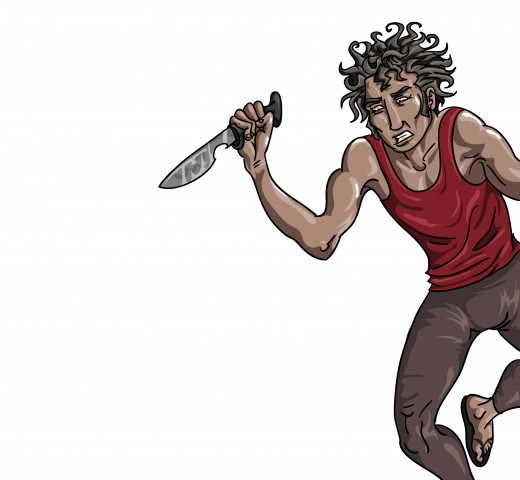Psychosis and violence; do people need protecting from the mentally ill?

Introduction
Each time a report of a hideous mass-murder hits our television screens we strive for an explanation as to how a human-being could reach the point where he could commit such an act of barbarism. To provide a valid explanation for why a person at a particular time behaved the way he did requires reference to multiple factors, drawing on individual, social, cultural and environmental causes. Despite this the media, along with many within the general population, seek a simple reason to account for the atrocity. A common response is to assume that the perpetrator must have been insane.
The argument is often circular and unhelpful. Only someone mentally deranged could be capable of such an extreme act of violence; surely a sane person wouldn’t behave this way? If only we could medicate these mentally ill people, remedy their brain diseases, the world would be a much safer place, wouldn’t it? Maybe it gives the majority some security and comfort to believe that extreme and inexplicable violence could be averted by the more effective management of a small minority (the insane).
But is there any evidence that better treatment of the insane would protect the public from future mass homicides? What types of mental disorders are people referring to when they assume that there is a group of insane people posing a major threat to everyone? What is the discrepancy between public perception of risk of being the victim of violence perpetrated by a mentally ill person and the actual risk of such an eventuality? This hub will try to address these questions.
Which mental disorder is the public most concerned about?
When the media or a lay-person expresses concern about being victimized by the insane, which group of psychiatric patients is being referred to?
A common mantra of psychiatrists in the developed world is that the rates of mental illness are on the increase. More and more of us are finding we fall within the criteria of the increasing number of mentally disordered categories espoused by the psychiatric system. Indeed, the latest version of the Diagnostic and Statistical Manual of the American Psychiatric Association (DSM – 5) will for the first time include the grief of bereavement as a formal mental disorder; thus, from May 2013 when DSM – 5 becomes operative, anyone feeling low in mood for a couple of weeks after the death of a loved one will officially join the growing masses of the insane!
The general public tend to be most fearful of a specific sub-set of people with mental health problems who hear voices, become paranoid and lose touch with reality. Mental health professionals refer to these kinds of experiences as psychoses. Psychiatrists label them as “schizophrenic.”

Evidence for a link between psychosis and violence
A comprehensive review of the scientific evidence (1) concluded that there was a small but independent link between schizophrenia and violence. In a survey of over 10,000 people, 8% of those who had a diagnosis of schizophrenia had been violent as compared to 2% of those without the diagnosis (2). Although this four-fold increase in risk of violence for psychosis-sufferers might sound substantial, two further considerations provide perspective. Firstly, other factors known to increase the risk of violent behaviour (for example, being victim of childhood abuse and witnessing violence being inflicted on others) are common occurrences in the histories of psychosis-sufferers. Therefore, the small increase in risk of violence for those with a schizophrenia diagnosis might not be directly attributable to the mental illness per se.
Secondly, other risk factors for future violence (see Table 1), which apply to any person irrespective of mental illness, are more potent predictors than a diagnosis of schizophrenia. Both drug misuse and alcohol misuse are each a much stronger predictor of future violence than psychosis.
Furthermore, in comparison with a combination of male, young age and low socio-economic status, the risk of violence associated with a mental disorder is a modest one (3).
Risk Factor
|
|---|
Young age
|
Male gender
|
Alcohol misuse
|
Drug misuse
|
Victim of bullying
|
Victim of childhood abuse
|
Witnessed violence within the family
|
Extreme poverty
|
Access to weapons
|
School truancy
|
Anger control problems
|
Tendency to blame others for problems
|
Obsessive interest in weapons/explosives
|
Loner, few close friends
|
Gang involvement
|
Employment problems
|
Personality disorder/psychopathy
|
Active symptoms of mental illness
|
Impulsivity
|
Table 1: Risk Factors for Violence
Psychosis and homicide
The concept of a psychotic killer on the loose is a common one in the world of fiction. But how often do people with psychoses become murderers?
A British survey found that only 5% of people convicted of homicide had, at some time in their life, acquired a diagnosis of schizophrenia (4). Similarly, an analysis of all murders committed in England and Wales between 1997 and 2005 reported that 10% (510 out of 5189) had mental health problems at the time of the index offence (5). Given that psychiatric researchers often assert that as many as 1-in-4 people within the general population will experience some form of mental disorder within a 12-month period, these homicide figures suggest that the link between psychosis and extreme violence is a weak one. Indeed, it has been estimated that the risk of being murdered randomly by someone with psychosis is about 1 in 10 million, broadly the same as being struck by lightning (6). Also worthy of note is that the incidence of homicide by people with mental health problems has remained at the same low level since the early 1990s.
Popular misconception
Despite these figures suggesting it is irrational to worry about being assaulted by the mentally-ill, the general public often overestimate the risk of violence. Two sources of information may be responsible for this misconception.
Firstly, sensationalist reporting by the media can distort perceptions about the level of dangerousness of people with mental health problems. For example, a survey of British newspapers revealed that 46% of stories about the mentally ill referred to acts of violence (7); an astonishing statistic when one considers that psychosis-sufferers living in the community are 14 times more likely to be the victims of violent crime than to be convicted of an act of violence (8).
Secondly, western psychiatric services often present themselves as primarily fulfilling a containment role, protecting the public from the insane. Formal and informal coercion are used widely in both the UK and USA to aid the management of people with psychosis (9). Legislation in Britain, and within some states in the USA, permits psychiatrists to force patients to take their medication under threat of being detained in hospital.
Psychiatry’s claim that they perform a major public protection role is disingenuous. As already illustrated, the risk presented by mentally ill people is a very modest one. Furthermore, applying greater coercion to people with mental health problems might make the lay-person feel safer but it would make no appreciable impact on actual risk. Risk assessments for future violence (irrespective of whether a mental disorder is present) are notoriously non-specific and identify many false positives i.e. many people are labelled as being at risk of violence who will not display any violence in the future. Even with the most detailed and laborious risk assessments, for every one homicide perpetrator correctly identified there will be 97 false positives (10). No civilized society could justify incarcerating large numbers of its citizens on the basis that the odd one might be dangerous.
References
(1) Walsh, E et al. (2002). Violence and schizophrenia: examining the evidence. British Journal of Psychiatry, 180, 490 – 495.
(2) Swanson et al. (1990) Violence and psychiatric disorder in the community: evidence from the Epidemiologic Catchment Area surveys.Hospital and Community Psychiatry,41,761-770.
(3) Monahan, J. (1997). Clinical and actuarial predictions of violence. In Modern Scientific Evidence: The Law and Science of Expert Testimony(eds D. Faigman, D. Kaye, M. Saks,et al) Vol.I, pp.300-318. St Paul, MN: West Publishing Company.
(4) Shaw, J. et al. (2006). Rates of mental disorder in people convicted of homicide. British Journal of Psychiatry 188: 143 – 147.
(5) National Confidential Inquiry into Suicide and Homicide by People with Mental Illness – Annual report: England and Wales 2009.
(6) Szmuckler, G. (2000). Homicide Inquiries: Do they make sense? Psychiatric Bulletin 24, 6 – 10.
(7) Ward, G. (1997), Making Headlines: Mental Health and the National Press. London: Health Education Authority.
(8) Walsh E et al. 2003, ‘Prevalence of violent victimisation in severe mental illness’, British Journal of Psychiatry, 183, 233–238.
(9) Bentall, R.(2009). Doctoring the Mind: Why Psychiatric Treatments Fail. Penguin Books.
(10) Szmuckler, G. (2001). Violence risk prediction in practice. British Journal of Psychiatry 178, 84 – 85.









